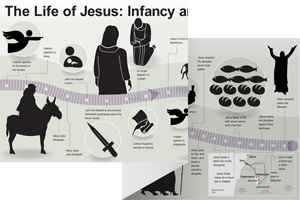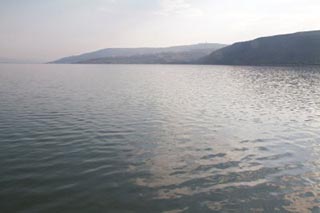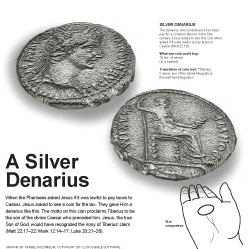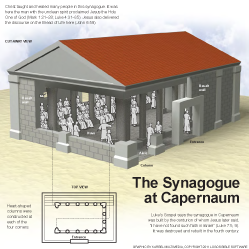6:1–15 Jesus performs another miraculous sign: feeding a crowd of about 5,000 men (besides women and children) with five loaves and two fish. This event is recorded in all four Gospels (Matt 14:13–21; Mark 6:32–44; Luke 9:10–17). On the symbolism of Jesus’ signs in John, see note on John 2:11. |
 Miracles of Jesus Table
Miracles of Jesus Table
Jesus Feeds 5,000 | |||
6:1 After these things See note on 5:1.
sea of Galilee A large freshwater lake in northern Palestine, 13 miles long by 8 miles wide and up to 150 feet deep.
in northern Palestine, 13 miles long by 8 miles wide and up to 150 feet deep.
Tiberias This alternative name for the Sea of Galilee also was the name of a city on its western shore. Tiberias was the largest and most important city in Galilee and was the regional capital for Herod Antipas.
was the largest and most important city in Galilee and was the regional capital for Herod Antipas.
6:2 large crowd Compare Matt 14:14; Mark 6:34. John’s account of this miracle is essentially the same as that in the Synoptics.
6:4 Passover This is the second of three Passovers mentioned by John (compare note on John 2:13).
Israelite Feasts in John’s Gospel | |
Passover (3 different years) | |
“a feast of the Jews” | |
Tabernacles | |
Dedication (Hanukkah) | |
6:5 Philip One of the first disciples called in John’s Gospel. See note on 1:43.
6:6 he said this to test him The narrator clarifies that the purpose of Jesus’ question is didactic. He is not seeking knowledge from Philip.
6:7 Two hundred denarii The amount referred to here, 200 denarii, was a substantial sum. A denarius was about a day’s wage for a laborer. See Matt 20:2; note on Mark 6:37.
6:9 five barley loaves and two fish A relatively small amount of food, normally enough for one or two people (compare note on Matt 14:17).
6:10 approximately five thousand See note on Matt 14:21.
6:13 twelve baskets See note on Matt 14:20.
6:14 the Prophet See John 1:21 and note (compare 4:19 and note).
 Jesus’ Fulfillment of Old Testament Prophecy Table
Jesus’ Fulfillment of Old Testament Prophecy Table
6:15 to make him king The people recognized Jesus as the Messiah but wrongly equated that idea with political revolution.
6:16–21 Three of the four Gospels record the disciples seeing Jesus walking across the Sea of Galilee. In all accounts, the scene directly follows the feeding of the 5,000. Compare Matt 14:22–33; Mark 6:45–51. |
6:17 a boat Most likely a fishing boat, since several of the disciples were professional fishermen before Jesus called them.
Capernaum They were on the eastern shore of the sea; Capernaum was on the northwest shore (see note on John 2:12).
6:19 twenty-five or thirty stadia They were roughly halfway across the sea. The distance from the eastern shore to Capernaum was six miles or more.
walking on the sea See Mark 6:48 and note.
Miracles at the Sea of Galilee | |
Jesus Calms a Storm | |
Jesus Walks on Water | |
The Miraculous Catch of Fish | |
A Second Miraculous Catch | |
6:20 It is I The Greek phrase used here, literally rendered as “I am,” evokes the motif of Jesus’ “I am” sayings (see 4:26 and note; note on Mt 14:27).
6:22–58 This discussion about Jesus as the “bread of life” is often understood as John’s treatment of the Lord’s Supper (also called Holy Communion or Eucharist). The Synoptic Gospels record Jesus’ instituting the observance during the Last Supper |
6:26 Truly, truly See note on 1:51.
you ate of the loaves Jesus accuses the crowd of following Him in pursuit of material satisfaction, not out of genuine faith.
6:27 the Son of Man See note on 1:51.
set his seal See note on Rev 5:1.
6:28 What shall we do The people are asking what actions are required by God, missing the point that eternal life is something that will be given to them (John 6:27). They may have understood Jesus’ reference to food in the previous verse to be observance of the law rather than Jesus Himself.
6:29 you believe The only “work” necessary for salvation is faith in Jesus as the Messiah sent by God.
6:31 the manna Refers to the events of Exod 16:4–36 and Yahweh’s miraculous provision of bread for His people in the wilderness. Jewish tradition looked for the Messiah to provide manna as Moses had (as depicted by the Jewish work Ecclesiastes Rabbah 1.9).
He gave them bread from heaven to eat Quoting Psa 78:24. The people are still focused on their earthly, material needs.
6:32 Moses did not give you bread from heaven The manna in the wilderness was physical bread for their physical needs. The “true bread from heaven” is spiritual.
true bread from heaven Jesus is emphasizing His role as the one sent from God in heaven to fulfill God’s plan to sustain His people with eternal life. Jesus’ entire discourse on the “bread of life” is essentially an extended interpretation of Psa 78:24 as quoted in John 6:31.
6:35 I am the bread of life Since the audience continues to miss the point that Jesus is referring to Himself as the one sent by God, Jesus makes the point explicit.
will never be hungry Alludes to ot expectations of divine redemption (compare Isa 49:10; 55:1).
6:36–40 Jesus briefly sets aside the topic of the “bread of life” to expound on the issue of the Jews’ persistent unbelief, reiterating His role as agent of the divine will and stressing that eternal life is gained through belief in Him. |
6:37 comes to me I will never throw out No one who believes in Jesus will be rejected by Him.
6:38 will of the one who sent me Compare John 5:19 and note.
6:40 raise him up on the last day Alludes to the belief in bodily resurrection. See note on 5:29.
6:41 the Jews In this context, “the Jews” seems to refer to those present and listening to Jesus’ teaching in the synagogue at Capernaum (v. 59; compare note on 1:19). They are displeased by the implications of His teaching. Their reaction evokes the image of Israel grumbling against Moses in the wilderness. Compare Exod 17:3.
6:42 Jesus the son of Joseph Knowledge of His earthly origin leads the people to reject His claim to heavenly origin (compare Matt 13:55).
6:45 And they will all be taught by God Jesus quotes Isa 54:13 in support of His assertion that true disciples will recognize Him in the teachings of Scripture.
6:46 This verse is probably a parenthetical insertion to clarify that “taught by God” does not imply that any person has seen God. John’s phrasing is very similar to that in John 1:18. |
6:47–65 Jesus’ teaching in this section repeats and reinforces the themes laid out in vv. 26–45. Belief in Jesus leads to eternal life. He repeats the metaphor that He is the “bread of life” (v. 48) and heightens the contrast between the manna that provided only physical nourishment and the bread from heaven that provides eternal life (vv. 49–51). His teaching is interrupted again by the misunderstanding of the audience (v. 52) and their willful rejection of a spiritual concept they cannot understand (vv. 60–61). |
6:51 is my flesh Jesus’ physical death is the price for the world’s spiritual life. The reference to “flesh” likely points back to 1:14. See note on 3:6.
6:52 How can this man give us his flesh The audience remains unable to understand that Jesus’ language symbolically points to a spiritual reality, not a physical requirement.
6:53 eat the flesh As if to underscore the absurdity of their confusion, Jesus presses the metaphor further, using the literal imagery of eating and drinking that they had assumed as the context. Eating and drinking are metaphors for faith (see v. 35 and note). Jesus makes the point that faith in Him—to the point of partaking of His role in the world (including His suffering)—is the way to God.
6:54 eats my flesh and drinks my blood In light of v. 35, this statement appears to refer metaphorically to believing in Jesus. This section of the discourse and especially Jesus’ language here evokes the strongest connections to the Lord’s Supper. See note on vv. 22–58.
6:59 the synagogue See note on Mark 1:21.
Capernaum See note on John 6:1.
6:60 This saying is hard Even Jesus’ own disciples were confused and put off by this teaching.
6:62 ascending Compare Mark 16:19.
6:63 the flesh profits nothing See note on John 3:6.
6:66–71 While other followers turned away from Jesus because of the difficulty of this teaching, the Twelve reaffirm their commitment to Jesus, and Simon Peter acknowledges their acceptance of Him as Messiah. |
6:68 Simon Peter Compare Peter’s confession in Matt 16:16. The Synoptic Gospels (Matthew, Mark, and Luke) depict Peter in the role of spokesman for the Twelve (see Matt 14:28). His prominence in the Synoptics and their account of the formation of the Twelve seem to be assumed here. Peter is only mentioned previously in John 1:40–44 where he is called as a disciple and renamed.

|
About Faithlife Study BibleFaithlife Study Bible (FSB) is your guide to the ancient world of the Old and New Testaments, with study notes and articles that draw from a wide range of academic research. FSB helps you learn how to think about interpretation methods and issues so that you can gain a deeper understanding of the text. |
| Copyright |
Copyright 2012 Logos Bible Software. |
| Support Info | fsb |
 Loading…
Loading…







